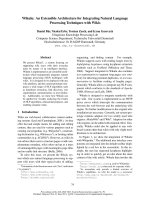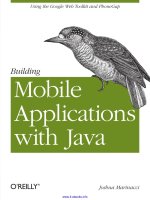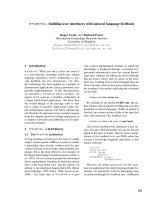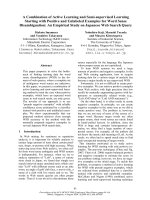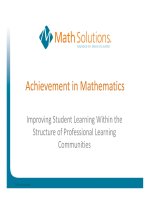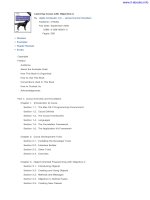Building Learning Communities with WIKIs
Bạn đang xem bản rút gọn của tài liệu. Xem và tải ngay bản đầy đủ của tài liệu tại đây (208.57 KB, 8 trang )
DRAFT
Building Learning Communities with WIKIs
Dan Gilbert, Helen Chen, Jeremy Sabol
Introduction
As more students have access to more tools and more wireless networks, opportuntieis to
collaborate, participate, and define how knowledge is organized are opening up at a
dramatic pace.
What is a WIKI:
In the broadest terms, A WIKI is a software tool designed to encourage more people to
share more information more easily than before. Wikipedia, an online encyclopedia
editable by anyone in the world, is perhaps the best known WIKI in the world and is
often used as an example of how a WIKI can work. While Wikipedia is obviously a
powerful tool – and one of the authors’ favorite resources on the Internet – it is much
more of an exception than the rule when thinking about WIKs.
Wikipedia’s defines a WIKI (as of February, 2006) as
“ a type of website that allows users to easily add and edit content and
is especially suited for collaborative writing. The name is based on the
Hawaiian term wiki, meaning "quick", "fast", or "to hasten"…In
essence, wiki is a simplification of the process of creating HTML web
pages combined with a system that records each individual change that
occurs over time, so that at any time, a page can be reverted to any of
its previous states”
At Stanford’s Center for Teaching and Learning () WIKIs are
introduced to faculty and instructors through faculty workshops on teaching and
technology and through one to one consultations. CTL A wiki is a simple collaborative
website that can be edited directly through a web browser (Internet Explorer, Netscape,
etc.). It can be used to generate simple webpages, share documents, and support student
groups working together.
Background: How did we get to working with WIKIs
This article is an outgrowth of the work that the authors did to present this work at the
Educause Learning Initiative (ELI) Conference in January 2006. The authors reviewed
multiple cases where WIKIs were used in a variety of courses taught at Stanford
University. While most of these courses were ordinary Stanford courses with
undergraduates and graduate students led by Stanford faculty and instructional staff.
The authors analyzed these case studies, looking for patterns on how WIKIs were able to
support learning communities. We set out to create a tool that would provide a
framework for analyzing how WIKIs actually worked in learning communities. In the
process, we also developed a tool that instructors can use to determine whether or not a
WIKI is the right match for their courses. We believe that this practical tool will be
extremely useful as instructors will be able to decide within a few minutes whether or not
a WIKI makes sense for the specific learning aims of their courses.
After identifying the elements of the WIKI that we wanted to highlight, we searched for a
metaphor that would help explain how these different steps fit together. Initially, we
explored ideas around the life cycle of a WIKI and thought that cell biology or water
cycles might help explain how WIKIs develop, thrive and die in academic settings.
We moved beyond the life cycle metaphors and into board games by thinking that the
steps to designing, implementing and sustaining a WIKI are carried out in some sort of
sequence. Each step represented a box on a game board – Start was developing and
articulating learning goals. Specifically we moved to the metaphor of the classic Hasbro
board game “Chutes and Ladders”; within a course there were certain actions that could
accelerate the adoption of a WIKI as a community of practice (ladders) and other actions
that would restrict/retard the development of communities of practice (chutes). In each of
the cases we studied, specific actions from instructors and learners were mapped as
chutes and ladders as the entire group worked toward building a community.
Poster from ELI Conference in January 2006 used to analyze the implementation of the
WIKI and determine the utility of a WIKI in a university level course:
Designing the WIKI experience in class
Collaborative technologies are only as powerful as their users make them. In the
courses that we observed, learners had a wide range of abilities and technical confidence.
To get the most value out of the experience the course leaders all went through some
process of determining goals. How the course leader set the tone distinguished these
cases from one another. Before embarking on the path of using any technologies for
learning, it is critical for the instructor to determine learning goals for their students.
When those goals include collaboration, discovery, sharing, reflection, and a combination
of face-to-face and virtual activities, then a WIKI can be the right tool for accomplishing
that kind of work. If the instructor’s goals, however, focus more on individual research
and writing, then a WIKI will almost certainly add no value to the course.
A clear articulation of these goals should help decide the next step of developing
a technology plan. Building a technology plan requires answering several key
questions:
• What are the kinds of activities that students should be doing as a part of this
course? Collaborating, writing, researching, creating, etc.
• What technologies are available, supported, or supportable at my institution?
•
How much training will learners need to use the WIKI? While net gen learners
are certainly more facile with technologies, that certainly doesn’t mean that they
all pick it up within a few seconds.
After developing a technology plan, the design phase moves from designing the activities
that the WIKI will support to designing the interactions themselves. To advance the
usage of the WIKI and encourage the participation, the instructor needs to make the
expectations and rationale clear to learners. As with any activity, especially those
involving new technologies, learners must clearly see how they themselves will benefit
from using the tool. Learners can benefit from WIKIS by:
• learning new processes and tools for collaboration
• creating team archives and electronic portfolios that can serve them for future
courses
• developing a comprehensive view of their contributions to a project for evaluation
during the current quarter
In each of our cases, making the rationale explicit to learners proved invaluable to just the
basic use of the WIKI itself. In the case of the SCIL Summer Institute, students were the
most excited about using the WIKI when it became clear to them that the resources and
reflections that the entire community was assembling would be valuable throughout the
remainder of the course. Their work on the WIKI on day 1 and day 2 would serve them
on days 4 and 5 so they did it. One challenge however was that once the group separated
in person the perceived benefits disappeared.
Before introducing the tool itself, the instructor needs to/should/can develop the first page
with a basic structure for organizing the content of the WIKI itself. Creating a
framework for the WIKI not only seeds the community with some basic information, it
also helps to set expectations of the kinds of tasks that learners are going to use the WIKI
to support. In one case, the framework was simply the titles of the pages that were found
in the WIKI: course schedule, participant bios, useful links, images, specific discussions.
In another case, establishing the framework meant creating specific sections of the WIKI
for individual, small group, and whole class activities and reflections.
One of the more interesting things that we noticed in these cases was that there was not a
single time when a learner changed the framework of the WIKI. Obviously in a WIKI
environment, any learner could change the navigation or rearrange the nature of the
environment itself. It never happened though, and while we don’t have any specific data
to make a claim, we can speculate as to why this was the case. First, any tool that is
introduced by an instructor is initially received as the property of the instructor and not
necessarily a tool of the community. Because learners didn’t feel like they owned the
WIKI they may have been reluctant to edit the pieces that they saw as fundamental to the
environment itself. Another speculation is that users may have hard a harder time
understanding that any changes that they made could be undone. There could very well
have been a great fear in changing something that could impact every member of the
community. In general users were much more willing to add text rather than edit or
delete other text.
Even with the framework in place, the rationale clear, a technology plan in place and
learning goals clarified, the instructor will have a static webpage to show for this effort.
In terms of efficiency, this is obviously not a result that benefits students nor instructor. It
is important to emphasize though that a static webpage is not a failure. In particular a
static webpage can be valuable for students after the course is over as a resource for
future learning.
Implementing WIKIs to Build Learning Communities
The actual guts of the technologies differ only slightly between a WIKI and a static web
page. Both are accessed through a web browser from any computer in the world; neither
require any kind of installation or technical knowledge about how to use the computer
itself. Instead the potential practices that surround the use of each of these tools are what
differ greatly.
A WIKI offers far more potential for multiple authors. For these practices to even get off
the ground though, we found that the instructor needed to dedicate specific meeting time
to introduce the WIKI in class. Using class time sends a signal that participating in the
WIKI is a critical piece of the overall course. During this first interaction with the WIKI,
instructors can give students simple tasks to highlight the functionality of the WIKI.
Something like, find a useful site and post it to the WIKI. Of course these kinds of
activities are predicated on a healthy dose of computers in the room. While it might not
be necessary to have a 1:1 computer to person ratio, it is important that students have the
experience of posting to the WIKI in the presence of others in the virtual community. In
several cases, learners said things in class to each other like, “Just post it in the WIKI” or
“Did you put that link in the WIKI?” “Don’t email that to me, just put it in the WIKI”
These comments compel the learners to interact with the WIKI right there in real time.
Having students make their first posts in a community in real time gives them a chance to
connect with other learners in their community both physically and virtually. In the
case of the Philosophical Stages course, the instructors invested a significant amount of
energy to build connections among learners face to face. With a face to face relationship
among learners and with expectations of that relationship communicated by the
instructors, the students had a solid foundation for getting in to the WIKI itself.
The implementation of any new practice in a classroom benefits greatly from the ssupport
and validation from the instructor. In the cases that we saw, the instructor modeled
WIKI use in class to demonstrate the value that the practice would have in the bigger
context of the learning goals. In classrooms where the instructor’s computer is projected
large, the instructor can make both the process and the rationale for using the WIKI
explicit to students. In each of the cases we observed seeing the instructor use the tool set
some baseline expectations of how they would use the WIKI throughout the quarter.
Modeling the WIKI use in class is critical to motivating learners to adopt WIKI
practices as a regular part of their study practices. Specifically, instructors need to
encourage posting, editing and commenting among their students. In each of the cases
that we observed, instructors were able to motivate students in a face-to-face setting to
post to the WIKI. In the case of Mechanical Engineering students, the professor kept the
WIKI projected on one of the in-room computers so that it was a constant presence in the
room itself. This constant presence afforded the opportunity for the instructor to
comment on specific WIKI posts in a face-to-face setting. We suspect that the
recognition of receiving feedback from the instructor during class motivated students to
continue to post. Likewise, in the Philosophical Stages class the instructors often
recognized and challenged student contributions during class time. As with most courses
regardless of the activity, recognition from the instructor can motivate higher levels of
participation (ARTICLE? CITATION?)
As the WIKI fills up with posts, reflections, and edits, it develops into a Knowledge Base
for the course and for the discipline. As more learners post a diverse set of resources and
reflections to the WIKI, the online space becomes the place to start for learners when
thinking about the subject matter. During the SCIL Summer Institute the course WIKI
became the place to start when looking for information on designing learning spaces. As
soon as the institute ended, however, the WIKI lost its importance in the community as a
the place to start for finding resources on learning spaces. Without the face-to-face
community to keep the practices alive, this WIKI slid backwards from an active and
growing knowledge base to a static web resource that has only been used occasionally
from former students in the class. A follow-up email from the instructor that had the
specific goal of motivating future posts generated only a few email replies, but no future
posts. In the instructor’s opinion, generating content on the WIKI would require bringing
the learners back for a face-to-face meeting to create enough motivation to participate in
a virtual community.
Sustaining Communities of Practice
In the best cases, a WIKI becomes a sustaining community. In the case of a learning
community, learners must move from just adopting the practices to adapting the tools as
a first step to keeping the community sustained. This stage can see the community
moving from a centralized top-down structure where the instructor’s expectations
motivate behavior to a more organic community where learners, we get to decide what to
include and how to organize it; and further, how do we modify the tool to meet our needs
Collaborate Actively
Foster Feedback
Evaluate WIKIs Usefulness: Is it worth it. At any point
Chutes and Ladders: (how to9 include this? Do we need it?)
Takeaways:
The goals of the class have to
Case Studies:
Case Study and
Wiki Technology
SCIL Summer
Institute on
Learning Space
Design
[Swiki-Wiki]
Description
Wiki Goals
Key Learning Milestones
A one-week
intensive
workshop for
architects,
academics, nonprofit staff, and
graduate students
to integrate
learning theory
into the design of
physical spaces.
To establish a
web presence for
individual
reflection and to
create a
knowledge base
for attendees to
reference after
course
completion.
Dedicating time in class for the
first wiki posts gave learners the
chance to see that the instructor
valued the virtual interactions; it
also created an opportunity for
learners to support each other
(Box 6). The biggest hurdle was
moving past the stage of a
knowledge base and into a
community. This wiki was a tool
that learners used for the week
they were in class; after class
ended, so did their close
connections with fellow learners
(Boxes 7 and 10).
ME013N:
Designing the
Human Experience
[Tiki-Wiki]
A project-based
introductory
freshman seminar
on design
engineering
research project
experimenting
with blogs and
wiki
environments.
To facilitate
student
integration and
synthesis of
learning through
increasing
student
awareness of
learning and
articulating
connections
between learning
and the design
process.
Using templates and creating a
structure for the wiki (Box 4)
were extremely important in
introducing the wiki to the
students and getting them to use
it. The templates included space
for students to put in their IM
names, availability for meetings,
and space for meeting notes, team
decisions, etc. (Box 7). What was
most challenging was developing
strategies to model giving and
receiving of quality feedback
(Box 13).
Institute on
Engineering
Education (ISEE)
workshop
[WikiWikiWeb]
A weeklong
workshop
designed to build a
community among
twenty research
fellows from five
institutions.
To give
participants a
place to capture
sources of
learning and
inspiration
during the
institute
including links,
documents,
photos, insights,
questions, and
A measure of success was
identified when one of the
scholars (a wiki novice) said to a
colleague: “Don’t email me the
reference, just put it in the wiki!”
To support active collaboration
(Box 12), we find that an
advocate is necessary – someone
who continuously brings the wiki
back into the forefront of the
work as a place for emails, notes,
resources and who emails the
Philosophical
Stages Summer
Program
[Project Forum
Wiki]
A three-week
program for high
school students
that integrates
ancient
philosophy,
drama, and
interactive
technologies.
reflections.
team links to new material in the
wiki plus password reminders.
To create a
forum for
individual
reflection and to
create a
knowledge base
for attendees to
reference after
course
completion.
With younger students, creating
the intellectual and organizational
framework for the wiki was
critical to getting quality
comments; (Box 4). The
instructors worked to build the
face-to-face relationships among
learners during the class and
consequently, the wiki has
continued to be very active and
engaged around many of the
topics raised during the course
(Box 15). This is a great example
of how a wiki functions as a
community of practice.


